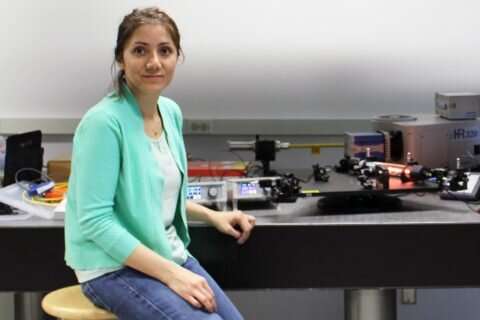
In a lab at USC, Mercedeh Khajavikhan engineers new structures that change the shape of light as it is transported. She creates groundbreaking structures in a field of science called photonics. Her work is important because it affects many things used in daily life, including lasers for imaging and sensing, fiber optic cables for advanced communications and computer chips to increase processing capabilities to a level earlier generations couldn't have dreamed of.
We caught up to Khajavikhan, the IBM Early Career Chair and associate professor of electrical and computer engineering at the USC Viterbi School of Engineering, to talk about the project her team is working on.
What do you work on?
Our lab conducts research that combines cutting-edge theories in mathematics and physics with photonics to create new engineering designs that shape light in ways we couldn't do without marrying the two fields.
What is photonics?
Photonics is a relatively new field of science that's about 100 years old. It is all about light: new types of lasers, holographic streams, light that transmits information, different ways to project light and use it across structures. It's about changing structures at the limits of optics, that everything should be symmetrical. If you get past that, then you get new opportunities to make light move more efficiently than standard lasers.
What is an 'active photonic system'?
Active photonic systems are materials used to manipulate light, and they are more important to modern life than people realize. In medical devices, they might be used to improve sensing and data collection. When implemented in semiconductors, they greatly increase computing power. They play an important role in navigation, where photonic gyroscopes provide improved GPS capabilities. Light can even be manipulated for optical data transmission. In fact, some new forms of twisted light beams could make the speed of our current fiber optics totally obsolete.
What kind of companies are interested in this research?
Photonics plays an important role in so many technologies, so you can imagine lots of industries are interested; everything from communications, transportation and defense, to entertainment, health, and manufacturing. It's hard to imagine many areas of engineering that don't benefit directly from photonics research. Any industry you can think of would directly benefit from smaller, smarter, more programmable technology—photonics is essential to that.
One particular area that stands out is semiconductor manufacturing. Today, the United States is at risk of falling behind our competitors—with great implications for our economy and security.
What is your goal in research?
To move the frontiers of science. What interests me most is gaining knowledge because knowledge is a wonderful thing. I like the challenge, and photonics is a field where you can press the limits to make non-symmetrical light—how much you can deform its structure and yet keep its shape.
What led you into engineering instead of traditional physics?
I wanted to be a physicist, but my dad said to study engineering because otherwise you'll end up as a high school teacher. By working in electro-physics electrical engineering, we are able to make real-world applications. USC is a good place for this because there are lots of faculty.
What's your latest research about?
We published a paper in Nature Physics that shows how we built a never-before-seen shape of light. Creating a new shape of light can be thought of as something like writing a new algorithm or a new piece of computer code; it has the potential to lead to any number of technological advances, depending on how creative the engineer is. It's possible our light form, and others like it, will one day help change the nature of communications, computing, transportation or any number of other industries society relies on every single day.
The better we get at building these materials, and the more creatively we think about them, the more we can do. You might think about photonic systems as something like Legos. You can build a lot of amazing things with Legos, even though the pieces only connect to each other on two sides and always in the same way. But if one day you invented pieces that were able to connect on all sides and move around and change color, you'd be able to do things you never previously imagined. That's what I love about photonic systems—each new structure we design and each new material we build opens up previously unimagined possibilities.
Explore further
Citation: Photonics research harnesses the power of light (2021, May 4) retrieved 4 May 2021 from https://ift.tt/3f7m7RV
This document is subject to copyright. Apart from any fair dealing for the purpose of private study or research, no part may be reproduced without the written permission. The content is provided for information purposes only.
"light" - Google News
May 04, 2021 at 06:31PM
https://ift.tt/3f7m7RV
Photonics research harnesses the power of light - Phys.org
"light" - Google News
https://ift.tt/2Wm8QLw
https://ift.tt/2Stbv5k
Bagikan Berita Ini















0 Response to "Photonics research harnesses the power of light - Phys.org"
Post a Comment